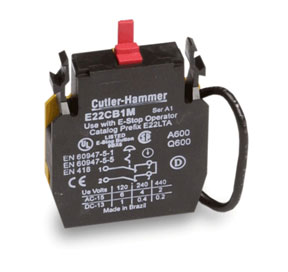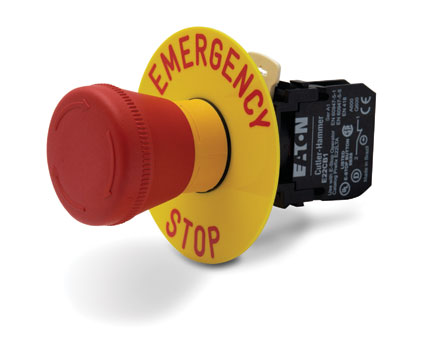With compliance to code and safety regulations continually taking on a more influential role across the industry, we will focus on European Machine Safety Directive EN418. Eaton/Cutler-Hammer supplied source information that has been compiled for the benefit of our readers.
EN418 – What is it?
EN418 is the European Standard for the Safety of Machinery Emergency Stop Equipment. It defines specific requirements for emergency stop devices and actuators. These requirements are summarized as follows:
• All Emergency OFF devices must be “self-latching” (maintained) devices. With regard to an E-Stop, this means it must be either a “push-pull” or “twist-to-release” device.
• The latching mechanism must be engaged prior to the electrical contact change-of-state to avoid a momentary OFF signal.
• All devices must have a “mushroom” head that is red in color.
• The background immediately surrounding the Emergency OFF device must be yellow in color.
• All Emergency OFF devices must have positive opening (direct opening) operation. This means there must be a direct mechanical link between the operation of the mushroom head and the contacts to drive the electrical contacts open. This protects against a potentially unsafe condition should contacts weld. A spring action contact does not comply with this requirement.
• The devices must not be reset automatically; manual reset is a requirement.
Why should AutomationDirect customers care about EN418?
Equipment shipped for use within the European Union must meet the requirements of the European Machinery Directive including EN418. If you ship equipment to Europe, the equipment must be in compliance with the machinery directive. If not in compliance, your customer risks significant cost impact, along with loss of time and potential business because European inspectors will prevent equipment from being energized until the machinery is made compliant. The Eaton/Cutler-Hammer EN418 compliant devices offered by AutomationDirect carry all applicable standards for application in Europe and North America; this enables OEMs to standardize on one device and meet global requirements.
What does AutomationDirect offer?
AutomationDirect carries the Eaton/Cutler Hammer E22 push-pull and trigger-action twist-to-release E-Stop devices that meet EN418 requirements. Part numbers and styles include: E22LTA2QB E-Stop trigger action maintained 40mm red mushroom pushbutton; and E22LPB2B, E22JLB2N8B, and E22JPLB2B with 40mm and 50mm push-pull maintained mushroom operators. To ensure acceptance by European machinery inspectors, these products are tested by DEMKO, a third party European Standards company.
What else should I know?
Ensuring compliance with EN418 is imperative to avoid problems associated with even minimal non-compliance. Most major suppliers of pilot devices have products that may meet the requirements of EN418, but some do not carry a third party testing certificate. Others may have products such as momentary devices and maintained twist-to-release devices that do NOT meet the EN418 requirements for positive opening operation. To ensure EN418 compliance, OEMs should thoroughly research and specify with their customer, the type of E-Stop device being used.
E22 Self-Monitoring Circuit Contact Block
 The E22 self-monitoring circuit contact block by Eaton/ Cutler-Hammer has an additional circuit to monitor its proper attachment to the Emergency Stop operator. While this configuration is not a requirement of the EN418 specification, it is an enhancement to overall E-Stop integrity especially where safety relays are being used. Without the self-monitoring circuit contact block, the E-Stop becomes a weak link in the E-Stop/safety relay circuit.
The E22 self-monitoring circuit contact block by Eaton/ Cutler-Hammer has an additional circuit to monitor its proper attachment to the Emergency Stop operator. While this configuration is not a requirement of the EN418 specification, it is an enhancement to overall E-Stop integrity especially where safety relays are being used. Without the self-monitoring circuit contact block, the E-Stop becomes a weak link in the E-Stop/safety relay circuit.
How it works: An extra circuit is wired in series with the normally closed (N.C.) contact. It monitors whether the contact block is removed from, or remains attached to the Emergency Stop operator. This provides an extra margin of safety and a higher level of integrity in the proper functioning of the Emergency Stop switch. Without the self-monitoring circuit contact block, there would be no detection of a fault if the contact block became separated from the Emergency Stop operator. The self-monitoring circuit contact block is designed so that as the contact block is mounted onto the operator, the plunger depresses and closes the self-monitoring circuit. If it becomes disengaged, the circuit will open and indicate a fault condition.
Originally Published: Sept. 1, 2005


